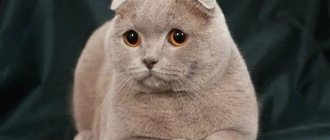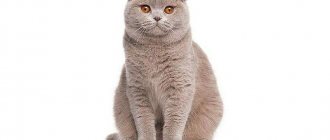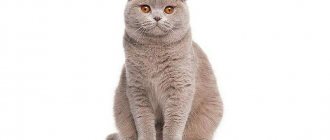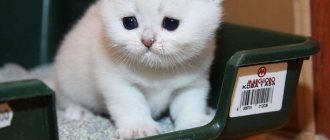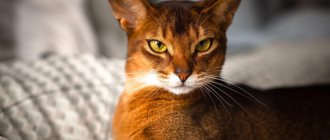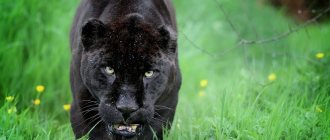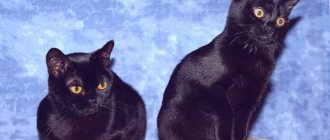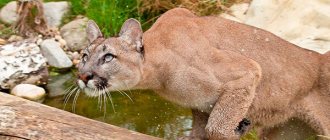The Lilac Briton was developed relatively recently as a result of experiments by breeders who were interested in the development of the breed. In the light shades of this color you can guess the blooming lavender, and the dark ones are more like the color of traditional English milk tea.
The cat with unusual fur quickly gained recognition in the international expert community. Let's find out if there is a relationship between the color of the fur coat and the character of the pet.
The history of the appearance of true British colors
The main role in the formation of new colors in cats belongs to genetics. The first cats bred without any rules, since the survival of the species was the main goal. But when the cat became a pet and settled next to a person, the situation changed dramatically.
The owners wanted to make some parameters more predictable in order to get kittens with a certain coat color.
Important! Based on the variety of registered colors (more than 200), the British cat ranks one of the first places in the hierarchy of cat breeds. The trademark is solid coat colors.
The gray-blue shade has been recognized as the main color for British Shorthair cats. The further evolution of colors began with him. The main achievements of the debut period are attributed to the English artist Harrison Weir, a great lover of British cats and a specialist who compiled the first standard of this breed.
During the selection, a line of solid colors was fixed, where, in addition to the main one (often called British), a palette of white, black, blue, cream, chocolate and red appeared. And at the end of the twentieth century, a purple tint was added to them.
Important! According to the rules of solid colors, the fur of a lilac British cat must be dyed from root to tip in one even color, without half-tone transitions.
Possible colors in the breed
Today the following groups are allowed:
- Solid;
- Patterned;
- Tortoiseshells;
- With white;
- Tipped;
- Silver;
- Golden.
Solid or solid cats are distinguished by their purity and uniform distribution of color. Black kittens from this group show a remnant of the tabby pattern, but after a few months it disappears without a trace.
According to the laws of genetics, in ginger cats (genetically red), stripes or dots are always visible on the coat.
Much attention is paid to smoky or silver options. Upon closer inspection, it is noticeable that their undercoat is much lighter than the main color.
Goldens have similar manifestations, but this color is rare in British kittens, but it looks impressive.
Tortoiseshell cats are born with two- or three-color coats. Males from this group are rarely born and cannot continue the race due to the characteristics of the body. The distribution of color spots is uniform; if black or red predominates, then this is considered a defect.
Patterned ones are divided into striped, spotted and marbled. The latter have a pattern on the sides that looks like thick lines twisted into a spiral. They are called rosettes. This color is very valuable.
Important: Britons with blue coats cannot have a silver tint.
Types and standard of lilac color
There is no such thing as monotony in nature, and the lilac color of the British is proof of this. It exists in three versions:
- Lavender light shade – close to the cold silver color of the metal.
- Warm cream lilac is the most common color.
- Dark Isabella – rich coffee with cream.
The alleles (types) of two genes are responsible for the process of coloring lilac British cats:
- Black color in cats is represented by the variants B (black), bb (chocolate) and blbl (cinnamon, cinnamon).
- Saturation depends on the lightening gene D, which exists in the combination dd (there is lightening) or Dm (caramel).
The aa (non-agouti) locus is required for solid colors. It is responsible for the lack of tabby pattern on the coat.
The color tone of British lilac kittens depends on the hereditary instructions that are passed on to babies from their parents. Breeding programs do not recommend mating with two partners with shades of lilac.
This leads to a deterioration in color - kittens are born with a dirty gray coat. Therefore, for mating with lilac, ginger cats (males) are usually taken.
British genetics have already identified patterns that can be used to predict the color of kittens in a litter.
- A lilac cat and a red cat give birth to lilac boys and lilac-cream girls.
- From the lilac cat and the red British cat you can only expect lilac and cream babies.
- But lilac kittens are never born from a ginger (red) couple.
In addition to the continuous cover, the lilac color appears in various combinations with other types of color.
- Tortoiseshell, where purple is a modification of black.
- Bicolor - lilac and white, rarely found in British cats.
- Smoky shades, when the root part of the hair is weakly colored or remains white, and the pigment only works on the ends of the hairs.
- Acromelanic color point - a lilac mask of varying saturation on the face and body parts: ears, paws, tail.
- Tabby is a purple coat pattern that sometimes fades into darker colors.
The lilac color in the British cat occurs in approximately 15-20% of matings, but solid colors are not common - they predominate in targeted breeding.
This is interesting! Over the century and a half of its existence, British cats have conceded the palm to other breeds several times. But since the beginning of the 21st century they have come back into fashion and become the most widespread group in England.
Features of color
Of the two hundred different colors of animal fur, the lilac Briton delights with its tenderness, subtlety, lilac or lilac tones. The peculiarities of this color are the following shades: gray-pink; lavender; isabella Felinologists can distinguish every subtle tone. This color is difficult to both describe in words and convey in photographs.
The light one is reminiscent of lavender, akin to pink with a cool silvery tint;
The middle one is called warm lilac, close to cream with a slightly purple tint;
Dark or isabella, like coffee diluted with milk.
General appearance of the breed and its changes since the beginning of breeding
The appearance of the British cat changed depending on the celphelinologists and breeders. To understand what this cat was like at the very beginning of its pedigree, you can turn to the work of the artist Harrison Weir, discussed above. He was a great animal lover, participated in many clubs and often depicted pets in his paintings.
The first images show a medium-sized cat, in a solid gray-blue color or bicolor (white with dark accents). At the end of the 19th century, the British still had long hair, which they obtained as a result of crossing with other breeds.
Later, work was carried out to consolidate individual characteristics. Breeders paid attention to the color and quality of the coat. As a result, the British cat's fur coat became like a thin plush with a stable gray-blue color.
During the First World War, purebred animals became a rarity. Long-haired Persians and other exotic breeds came into fashion, and the descendants of local rural cats faded into the background.
To save the native species, breeders even crossed the British with the French Chartreuse-Carthusian breed, which were not genetic relatives, but were very similar in appearance to their English counterparts.
Somewhat later, the descendants of mixed “marriages” with Persians were identified as a separate long-haired breed, and by 1970 the true British formed the type of cat that exists today.
- The cat is medium-sized, squat, with a well-developed chest.
- The head is rounded, with large cheeks.
- Wide set ears.
- Large round copper-orange eyes. Depending on the color, their color may vary.
- The cat's tail is of medium length, wide at the base and rounded at the tip.
- Short (relative to the body) legs, full rounded paws.
- The coat is dense, thick, and short.
For British cats, more than 200 types of colors are allowed, including new colors - silver, gold, lilac.
Popular colors for kittens
In the media and various illustrations, British kittens of a certain color are often found. This formed the opinion that true representatives of the British breed are only blue or whiskey colored.
In fact, more than 200 variants are recognized in the breed, including combinations of the main ones.
Popular colors:
- Blue;
- Gray with stripes;
- White with chocolate spots;
- Gray background with bright marble.
Recently, British chinchillas have been gaining popularity. About 1/8 of their hair is dyed, and the roots are very light. In smoky cats, dark pigment of any color occupies the largest part.
Do external factors affect the preservation of coat color?
All possible types of color transformations are subject to five rules:
- Age-related – in cats, children’s fur changes color towards puberty. The process of changing shades occurs in two directions: from light to dark and vice versa. Sometimes in the early period small spots may appear on solid colors, but later they disappear. The British lilac cat is prone to such changes in external characteristics.
- Weather - under the influence of ultraviolet radiation, the color of the coat becomes less saturated. Isabella lilac is quite capable of temporarily turning into lilac, but if you reduce the Briton’s exposure to the sun’s rays, the color will return to its original state. In the case of the lilac color-point, high ambient temperatures cause the mask on the cat's face and paws to darken, while lower temperatures cause the color to lighten to lavender.
- Age – as a lilac cat gets older, its color will definitely change.
- Diseases - British cats are not prone to hereditary diseases that can affect the color of their coat. However, even a common cold and taking medications will temporarily change the coat color of a lilac Briton.
- Poor nutrition is the most common cause of artificial influence on color. Sometimes a cat's diet affects the appearance of its fur so much that returning it to its original state takes too much time, effort and money.
Over the years of its life, the British lilac cat goes through several stages of color change. You need to carefully monitor such processes and, as far as possible, try to preserve the rare shade by all known means.
Origin story
This breed appeared in England in the 19th century. British kittens got their lilac color thanks to the long work of breeders and breeders. The Lilac Briton is not considered a separate breed; it is classified as one of the common British shorthair cats, the difference lies solely in the shade of the coat. The British woman became purple not under the influence of the color gene, but as a result of crossing recessive forms of pets of blue and chocolate shades. Interestingly, only 4 of the kittens are born purple. Some people are convinced that this tone was created when a Scottish Fold cat was crossed with a marbled cat. However, this opinion is not true, since this procedure does not make it possible to obtain a lilac color in cats, in addition, it leads to disorders at the genetic level.
The lilac Briton is now more popular than the Scottish Fold, which has an unusual amber color. Moreover, the cat is popular not only in the United Kingdom, but throughout the world.
Character and behavior of shorthaired lilac British
The influence of coat color on the behavior of an animal has not been studied enough, but some practical observations are known that allow us to draw conclusions about the presence of such connections. White cats, as a rule, are docile, and black cats are obstinate, striped tabbies tend to hunt wildly, and color-point cats are secretive and even treacherous.
The character of lilac cats is within the behavioral instincts of their breed, but leans towards a more loyal view of owners and family members. Typical British Shorthairs are reserved and often seek solitude.
Cats show indifference to other pets, and in case of conflict they prefer to retire to a safe place.
Against the general psychological background of their breed, lilac-colored Britons demonstrate more softness and even delicacy. The nature of these cats does not have the habit of active games, but the lilac ones are ready to take part in general fun and can even sit for a short time in the arms of the owner.
White and color point kittens
These cats have a distinctive feature - blue, green or copper eyes. At the same time, the color coding indicates the feature. White kittens are often born with small markings. Their color is dull and their sizes are minimal.
Just like with black solids, they disappear as they grow older. White kittens of the British breed cannot have a warm shade, only a pure and bright color.
Important: White color is distinguished from cream by the color of the nose. The latter have a warm shade. Cream is a derivative of red color in a lightened version.
Color point kittens have markings on the face, tail, paws, and darkened fur on the back. The main background is light. The unusual color was inherited from exotic breeds. The markings may have a tabby pattern. The background colors are black, purple, cream, red and chocolate.
Proper care and feeding
The British lilac cat is easy to care for, and its maintenance does not take much time.
Hygiene
Once a week it is necessary to comb the cat’s fur, and during active shedding, the procedure is repeated 2-3 times a week or even daily. A special mitten or standard combs work well with short lilac hair.
The British do not like water, so instead of bathing, you can treat the coat with a damp cloth. Lilac British cats are taught hygiene from an early age.
You also need to regularly remove the discharge that forms in the corners of the eyes and around the nose. Treating the ears of straight-eared Britons is not a problem. Use a cotton swab to remove dirt from the upper part of the ear, and the ear canal is cleaned with special drops or lotion.
Diet
The basis of the cat's menu (up to 90% of daily intake) is meat and fish. The diet must include vegetables, cereals, yeast and cottage cheese (milk). Adult British cats with lilac coloring are often given balanced industrial food, which contains the required amount of fats, carbohydrates, vitamins and microelements.
Sometimes the composition of the products has a negative effect on wool with a lilac color. For example, iodine, which is found in seafood, can change a cat's fur to a purple color, which is unusual for the British. Therefore, when changing food, you need to monitor the condition of your pet’s coat and adjust the diet in case of unexpected color changes.
Rare colors
Amber is a new and not yet approved species. Externally similar to golden, but more subdued. The peculiarity is the presence of single black hairs located nearby.
Doubts about color are caused by the fact that dark stripes or dots are visible against a warm background, and cats, not at the genetic level, can be either black or red. For now, Amber is recognized in one of the felinological organizations for the Kuril Bobtail breed.
Kittens with the rare fawn color are a gift for many breeders. It is a variation of lilac, but a very light shade. The color of the nose is beige and pink, as are the pads on the paws. Eyes amber or copper.
This is a monochromatic color, the pigment in the hairs is evenly distributed. The quality of British wool should not suffer from bleaching, despite its apparent softness.
Cinnamon or cinnamon is a derivative of the chocolate color. The color is solid and uniform, without blemishes or marks. The shade is delicate, slightly muted. The color of the nose of the cinnamon is brownish-pink.
There are two types of shade: yellow and red. It is layered on top of the base brown. The paw pads are colored similarly to the nose.
Upbringing
Breeders believe that the lilac color of British cats affects their character. Such pets demonstrate an increased level of learning ability. Unlike blue-gray Britons, they love communication.
Lilac cats enjoy being the center of attention, as long as they choose to do so. A cat that gets into a large family at an early age shows less independence and independence, which is characteristic of the British breed.
Video “Funny British cat babies”
The video shows newborn kittens of lilac and chocolate color.
Was this article helpful?
Thank you for your opinion!
The article was useful. Please share the information with your friends.
Yes
No
X
Please write what is wrong and leave recommendations on the article
Cancel reply
Rate the benefit of the article: Rate the author ( 1 vote(s), average: 5.00 out of 5)
Discuss the article:
Choosing a nickname for the handsome lilac
When choosing a cat name, the designation of lilac color is always a priority. Although in this matter professional breeders prefer to adhere to their own rules. The names of all pets in the litter begin with a certain letter and often contain the brand name of the nursery or a combination of the parents' names.
Therefore, the little lilac Briton goes to a new owner with a name that is already recorded in the pedigree documents.
However, the owner can give the pet another “unofficial” nickname, which he will respond to at home.
- Dark purple British cats are sometimes called Isabella and derivatives of this name. This is a tribute to the isabella color, the second name for the color.
- Often there are names starting with the letter “L” - Lilu, Lyalya, Laska, Lavender.
- The nicknames traditionally include a reference to the English pedigree roots of this breed - London, Albina (apparently they mean Albion), York and even Westminster.
- For some time, aristocratic titles were in fashion - Count, Duke, Queen Margot (although this is closer to France, it is quite common in the pedigrees of British cats).
English cats have a complex character, but this in no way affects the persistent desire of fans of the breed to have just such an animal. The appearance of a new color in a group always causes a fresh wave of interest, and the lilac color is still among the rare and most sought after.
The only difficulty is the need to find a conscientious breeder, but such little things never stop true connoisseurs of cat beauty.
Who is the lilac Briton suitable for?
When choosing a Lilac pet, the important arguments are:
- British kittens, like their parents, have the same lilac-colored characteristics that will be a source of pride for their owner.
- The British have a soft, good-natured character; pets immediately become family favorites.
- Lilac is brought into a home with small children, and they get along well.
- They tolerate loneliness calmly and do not get bored, which is important for busy owners.
- Balanced by nature, they are clean and will not create a mess in the house.
Character
The character does not particularly depend on whether we are talking about short-haired lilac British or marbled ones. These two types of furry pets are very soft, charming and playful. They are not characterized by English stiffness and arrogance. The peculiarity of the breed is also that the pets remain playful until old age. Feeling good, they can resemble children even in old age.
Animals like to climb onto the highest furniture in the apartment and from there watch the people below. Cats are loyal and devoted to their owners, although they often do not show their love openly. The British try to stay close, but at the same time stay away. Breeders note that animals of this breed perfectly sense the owner’s mood, so when it wants to be better, the pets stay away, fearing to fall under the “hot hand.” Despite the non-conflict nature of the cat, it is better not to have a dog in the house, because the animal may develop jealousy and will stay away.
PHOTOS OF LIVEL BRITISH KITTENS
Below is a gallery of photos of lilac British kittens.
| In our cattery you can “buy a real British kitten.” We have many different colors, we will help you choose and answer all your questions! |
Please rate the article!
(1 star - didn't like it, 5 stars - liked it) Thank you!
